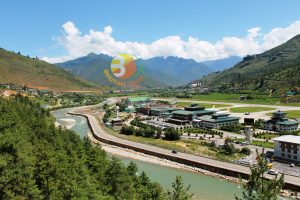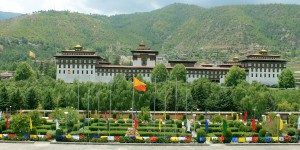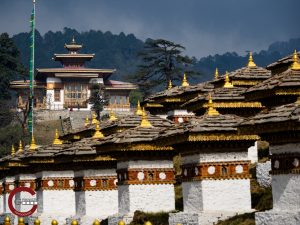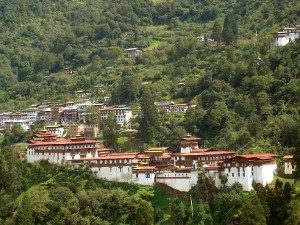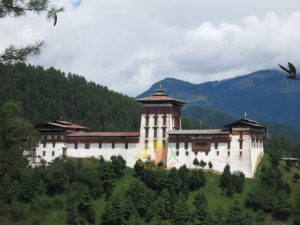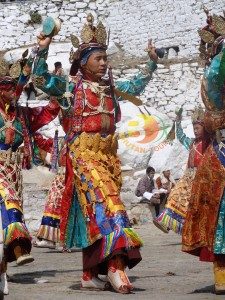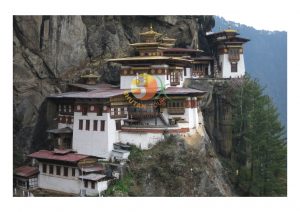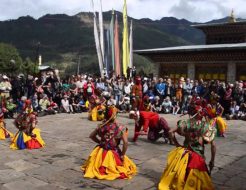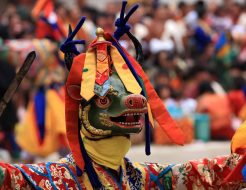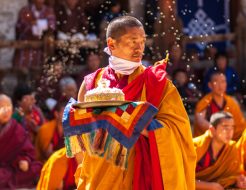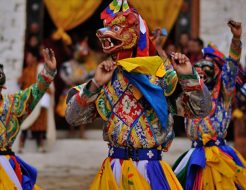(10 Nights / 11 Days)
Paro-Thimphu-Punakha-W/due-Trongsa- Phobjikha Bumthang)
Day 01: Arrive Paro by Druk Air OR Bhutan Airlines
The flight into Bhutan takes you close to the great Himalayas, offering dazzling scenic views of some world’s highest glacial peaks. As you enter Paro valley, you will sweep past forested hills with the silvery Pa Chu (Paro river) meandering down the valley below. Paro Dzong (fortress) and Ta Dzong (watchtower) on the hills above the town will be a fine sight. Our representative will meet you at Paro airport, and after completion of arrival formalities, you will be transferred to Bhutan’s capital, Thimphu, an exciting blend of tradition and modernity. Overnight at the hotel in Thimphu.
Day 02: Thimphu
Today’s full day of sightseeing in Thimphu valley includes, visit; National Memorial Chorten: The building of this landmark was envisaged by the third king, His Majesty Jigme Dorji Wangchuck, as a monument to world peace and prosperity. Completed in 1974 after his untimely death, it is both a memorial to the Late King (“the Father of modern Bhutan”) and a monument to world peace. The paintings and statues inside the monument provide a deep insight into Buddhist philosophy.
Then proceed to Buddha Dordenma is a gigantic Shakyamuni Buddha statue under construction in the mountains of Bhutan. The statue will house over one hundred thousand smaller Buddha statues, each of which, like the Buddha Dordenma itself, the Buddha Dordenma is sited amidst the ruins of Kuensel Phodrang, the palace of Sherab Wangchuck, the thirteenth Desi Druk, overlooking the southern approach to Thimphu, the capital of Bhutan.
Institute for Zorig Chusum (commonly known as Painting School) where students undertake a six-year course on the 13 traditional arts and crafts of Bhutan;
After lunch proceed Textile and Folk Heritage Museum: These museums, both of which opened in 2001, provide fascinating insights into Bhutanese material culture and way of life.
Trashichhodzong: This impressive fortress/monastery houses Secretariat building, the throne room of His Majesty, the King, and various government offices. It is also the summer residence of Chief Abbot and central monk body.
Overnight at the hotel in Thimphu.
Day 03: Thimphu / Trongsa (200 Km, 7 hours’ drive)
After early breakfast, drive up to Dochu-La pass (3,088m/ 10,130 ft) stopping briefly here to take in the view and admire the chorten, mani wall, and prayer flags which decorate the highest point on the road. If skies are clear, the following peaks can be seen from this pass (left to right): Masagang (7,158m), Tsendagang (6,960m), Terigang (7,060m ), Jejegangphugang (7,158 m ), Kangphugang (7,170 m ), Zongphugang (7, 060 m ), a table mountain that dominates the isolated region of Lunana – finally Gangkar puensum, the highest peak in Bhutan at 7,497m.
Then continue onwards, reaching Wangduephodrang town in time for lunch. From Dochu-la pass, it is a long, winding descent into the Wangduephodrang valley, which is about 1,700m below the pass. Take lunch at Wangduephodrang town, then continue on to Trongsa across Pele-la pass (3,300m/10,830 ft), the traditional boundary between east and west. The pass is marked by a large white chorten prayer flags. There is an abrupt change in vegetation at this point, with mountain forest replaced by high altitude dwarf bamboo.
Stop en route at Chendbji Chorten, patterned on Kathmandu’s Swayambhunath Stupa, with eyes painted at four cardinal points. It was built in the 18th century by Lama Shida from Tibet, to cover the remains of an evil spirit that was subdued at this spot.
Arrive at Trongsa late afternoon and check into the lodge for the night.
Day 04: Trongsa / Bumthang (68 Km, 3 hours’ drive)
After breakfast, visit Trongsa Dzong. Built-in 1648 it was the seat of power over central and eastern Bhutan. Both the first and second Kings of Bhutan ruled the country from this ancient seat. All four Kings were invested as Trongsa Penlop (‘governer’) prior to ascending the throne, and the present Crown Prince now holds the post. The Dzong is a massive structure with many levels, sloping down the contours of the ridge on which it is built.
Then drive to Bumthang, 68 km from Trongsa, a journey of about 3 hours, over the Yutong-La pass (3,400m/ 11,155 ft). The road winds steeply up to the pass, 28 km from Trongsa, then runs down through coniferous forest into a wide, open cultivated valley known as the Chumey valley.
On arrival in Bumthang, check in at your lodge overnight in Bumthang.
Day 05: Bumthang
Bumthang is the general name given to the combination of four valleys – Chumey, Choekhor, Tang, and Ura with altitude varying from 2,600m to 4,000m. It is home to many of prominent Buddhist temples and monasteries. Visit Kurje Lhakhang, where the saint Padmasambhava subdued a local demon and left his body imprint on a rock. The Jambey Lhakhang (7th-century temple), Tamshing Lhakhang (housing some of the oldest wall paintings in Bhutan) and Jakar Dzong (administrative center of the region). Stroll in the village, visit the little handicrafts shop at the entrance to the town, and perhaps take refreshments at a local restaurant. Overnight at the lodge in Bumthang.
Day 06: Bumthang / Gangtey / Phobjikha (190 km, 7 hours’ drive)
After breakfast drive to Gangtey / Phobjikha. In the mountains east of Wangduephodrang lies the beautiful Phobjikha valley, on the slopes of which is situated the great monastery of Gangtey, established in the 17th century. The village of Phobjikha lies a few km, down from the monastery, on the valley floor. This quite, remote valley is the winter home of black necked cranes, which migrate from the arid plains of Tibet in the north, to pass the winter months in a milder climate. Explore Gangtey village and Phobjikha valley. Overnight at the lodge in Gangtey / Phobjikha.
Day 07: Gangtey / Phobjikha / Punakha (70 km, 3 hours’ drive)
After breakfast drive to Punakha. Afternoon visit Punakha Dzong, a massive structure built at the junction of two rivers. Punakha was Bhutan’s capital until 1955, and Punakha Dzong still serves as the winter residence of the central monk body. Bhutan’s first King, Ugyen Wangchuck, was crowned here in 1907. The fortress has withstood several damages from fire, earthquake, and flood over the centuries. The latest flood, in October 1994, caused great damages to the fortress but miraculously spared its most holy statue. Also visit Khamsum Yulley Namgyal Chorten, the newly built stupa. Overnight at the hotel in Punakha / Wangduephodrang.
Day 08: Punakha / Paro (125 km, 4.1/2 hours’ drive)
After breakfast, drive to Paro, Afternoon visit to Ta Dzong, this in the past served as the watchtower for Paro Dzong (Rinpung Dzong) and now houses the National Museum. Then walk down the trail to visit Rinpung Dzong, built in 1646 by Shabdrung Ngawang Namgyal , the first spiritual and temporal ruler of Bhutan, the Dzong houses the monastic body of Paro, the office of the Dzongda (district administrative head) and Thrimpon (judge) of Paro district. The approach to the Dzong is a traditional covered bridge called Nemi Zam. Overnight at the hotel in Paro.
Day 09: Paro Visit Festival
Early morning after breakfast drive to Paro festival from road head walk through the bridge, over a stone inlaid path, offers a good view of the architectural wonder of the Dzong as well as life around it. The Festival is considered a major attraction and people travel from neighboring districts to participate in the event. Early in the morning on the last day of the celebration, the monk displays a gigantic Thangkha (embroidered painting), the Guru Throngdel, inside the Dzong. Throngdel is the especially impressive example of Buddhist art and never fail to amaze viewers. They are considered so sacred that simply seeing a Throngdel is said to clean the viewer of sin. Overnight at the hotel in Paro.
Day 10:
After Breakfast proceeds to Taktsang Palphug Monastery more famous as Paro Taktsang is a Buddhist temple complex which clings to a cliff, 3120 meters above the sea level on the side of the upper Paro valley, Bhutan.
The Taktsang Palphug Monastery is one of the most famous touristic destinations of the country and the cultural icon of Bhutan.
Visiting the Paro Taktsang Monastery is an unforgettable experience thanks to its unique location and the views of surrounding majestic mountains and emerald green valleys.
After lunch drives up the valley to Drukgyel Dzong, built in 1647 by the Shabdrung to commemorate the Bhutanese victory over the Tibetans in the war of 1644.
While returning to hotel visit en route, Kyichu Lhakhang, built in the 7th century by the Tibetan king, Songtsen Gampo. Overnight at the hotel in Paro.
Day 11: Depart Paro
After early breakfast in the hotel, drive to the airport for flight to onward destination.


